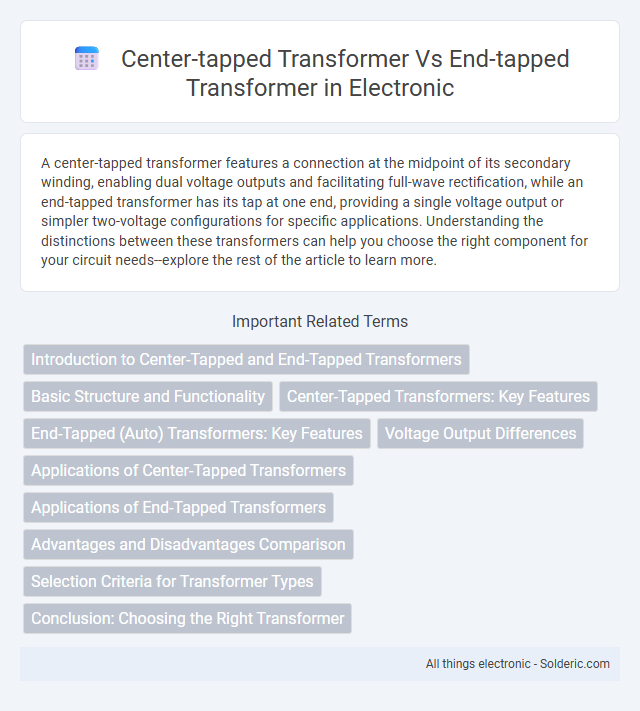A center-tapped transformer features a connection at the midpoint of its secondary winding, enabling dual voltage outputs and facilitating full-wave rectification, while an end-tapped transformer has its tap at one end, providing a single voltage output or simpler two-voltage configurations for specific applications. Understanding the distinctions between these transformers can help you choose the right component for your circuit needs--explore the rest of the article to learn more.
Comparison Table
| Feature | Center-Tapped Transformer | End-Tapped Transformer |
|---|---|---|
| Definition | Transformer with a tap at the midpoint of the winding | Transformer with a tap at one end of the winding |
| Output Voltage | Two equal voltages from center to each end | Single voltage output from entire winding |
| Common Usage | Full-wave rectifiers, split voltage supplies | Half-wave rectifiers, applications needing single output |
| Waveform | Allows full-wave rectification with two diodes | Typically used for half-wave rectification |
| Complexity | More complex winding, requires center tap | Simpler winding, no center tap needed |
| Cost | Generally higher due to more complex design | Lower cost, simpler manufacturing |
| Output Current | Split current on two halves of the winding | Current flows through entire winding only |
| Efficiency | Higher efficiency in full-wave rectification | Lower efficiency, used for basic applications |
Introduction to Center-Tapped and End-Tapped Transformers
Center-tapped transformers feature a secondary winding with a midpoint connection, enabling two equal voltages to be obtained from the same winding, commonly used in full-wave rectifier circuits and balanced power supplies. End-tapped transformers have secondary windings connected only at the ends, providing a single output voltage typically used for simpler voltage step-down or step-up applications. The key difference lies in the number of taps and their positions, which affect circuit design, voltage output configurations, and application suitability.
Basic Structure and Functionality
A center-tapped transformer features a secondary winding with a middle connection, creating two equal voltages relative to the tap, enabling dual polarity outputs or split voltages. An end-tapped transformer has its secondary winding connected at one end only, providing a single voltage output relative to the common ground. Your choice depends on whether you need balanced voltages for applications like full-wave rectifiers or a simpler single voltage supply.
Center-Tapped Transformers: Key Features
Center-tapped transformers feature a secondary winding with a connection at the midpoint, providing two equal voltages relative to the center tap, which often serves as a neutral or ground reference. This design enables efficient full-wave rectification in power supplies, reducing ripple and improving voltage stability. Your choice of a center-tapped transformer enhances circuit balance and simplifies dual-voltage applications in audio and power conversion systems.
End-Tapped (Auto) Transformers: Key Features
End-tapped transformers, also known as auto-transformers, feature a single winding with one or more taps used to adjust voltage levels efficiently. These transformers offer higher efficiency and lower cost compared to center-tapped transformers due to reduced copper usage and simpler construction. Your electrical systems benefit from their compact size and ability to provide variable voltage outputs without the need for separate windings.
Voltage Output Differences
Center-tapped transformers provide two equal voltage outputs relative to the center tap, allowing for dual polarity voltages ideal for split power supplies. End-tapped transformers deliver a single voltage output from one end to the other, resulting in a unipolar voltage supply. Understanding these voltage output differences enables you to select the appropriate transformer type for your specific electrical circuit requirements.
Applications of Center-Tapped Transformers
Center-tapped transformers are widely used in power supply circuits for creating dual voltage outputs and in push-pull amplifier configurations, enhancing efficiency and signal symmetry. These transformers facilitate split-phase power distribution, making them essential in residential electrical systems and audio equipment with balanced inputs. Your designs benefit from their ability to provide stable reference points and simplify rectification processes in various electronic applications.
Applications of End-Tapped Transformers
End-tapped transformers are commonly used in applications requiring multiple voltage outputs, such as in power supplies for audio equipment, where distinct voltage levels are necessary for operation. Their design allows for easy access to intermediate voltage points without a center tap, making them ideal for step-down transformers in low-voltage circuits and lighting systems. When selecting a transformer for your project, consider end-tapped configurations for efficient voltage regulation in complex electrical systems.
Advantages and Disadvantages Comparison
Center-tapped transformers provide a neutral midpoint, enabling dual voltage outputs and creating balanced currents that reduce noise and improve efficiency in audio and power supply applications. End-tapped transformers offer simpler construction and are often more compact, but they lack the ability to produce split voltages and may contribute to uneven load distribution. Your choice depends on whether balanced output or simplicity and size are more critical for your specific electrical project.
Selection Criteria for Transformer Types
Selection criteria for center-tapped versus end-tapped transformers primarily depend on the required output voltage configuration and circuit application. Center-tapped transformers are ideal for full-wave rectification in power supplies needing dual voltage rails or balanced loads, while end-tapped transformers suit simpler applications requiring single voltage outputs. Considerations include voltage regulation, load balancing, and cost efficiency to optimize transformer type for specific electrical system demands.
Conclusion: Choosing the Right Transformer
Choosing the right transformer depends on the application's voltage requirements and grounding needs; center-tapped transformers provide a neutral point for dual voltage outputs and are ideal for split-phase power systems. End-tapped transformers offer simpler design and are typically used for single voltage output where center tapping is unnecessary. Consider factors such as load balancing, safety, and circuit complexity when selecting between center-tapped and end-tapped transformers for optimal performance.
center-tapped transformer vs end-tapped transformer Infographic

 solderic.com
solderic.com